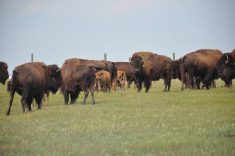About one in every 10 hog producers who were chosen to participate in the federal Hog Farm Transition Program have had a change of heart.
The $75 million program paid hog producers to sell their livestock, empty their barns and exit the hog business for a minimum of three years.
Starting in late 2009, cash strapped producers were invited to submit bids outlining how much money it would take to get them to exit the business. The program was designed to address producers’ short-term cash flow problems, reduce national hog inventories and limit the supply of market hogs being produced in Canada.
Read Also

Trump’s tariffs take their toll on U.S. producers
U.S. farmers say Trump’s tariffs have been devastating for growers in that country.
The program, administered by the Canadian Pork Council on behalf of the federal government, was supposed to bolster low hog prices, which were no longer covering the costs of production.
Gary Stordy, public relations manager for the pork council, said last week that about $72 million of the $75 million that was originally available has been allocated.
About 500 producers who submitted bids were approved for participation in the program, but more than 50 have since dropped out, he added.
On the Prairies, about 150 hog producers are still participating in the program, including 61 in Alberta, 15 in Saskatchewan and 74 in Manitoba.
Hog prices have rebounded since the program was unveiled nearly two years ago.
In August 2009, weekly hog market statistics provided by Agriculture Canada listed Saskatchewan hog prices at $100 per 100 kilograms.
Two years later, the same statistics listed Saskatchewan prices at nearly $183 per 100 kg, an increase of 83 percent over the past two years.
Stordy said prices have rebounded and the economics of hog production have improved, but production costs have also risen sharply, primarily due to increased feed costs.
Statistics Canada figures show Canada’s quarterly pig production for the three months ending Jan. 1, 2011 at about 7.12 million head.
A year earlier, shortly after the transition program began, the quarterly pig crop was pegged at about 7.2 million.
If those figures are accurate, the Canadian pig crop decreased by about 1.1 percent in the first year of the program. Pig crop is defined as the number of pigs born during a three-month period that were either sold or retained on hand by producers.















